A682

As the Jeffreys’ map of Yorkshire, above, published in 1771 shows, just south of Howgill Lane there was no road connecting Gisburn with the towns of East Lancashire. The route from Gisburn to Colne etc. was via Coal Pit lane along the side of Weets Hill, to Gisburn Old Road. (See Coal Pit Lane section below). What we now know as the A682 is a road developed by the Marsden, Gisburn and Long Preston Turnpike Trust; Marsden is the old name for Nelson. Turnpike trusts were bodies set up by individual acts of Parliament, with powers to collect road tolls to build, maintain and operate toll roads in Britain. Whilst they originated from the 17th century they were especially prominent during the 18th and 19th centuries when the increased commercial and industrial activity required improved road systems.
The Act of Parliament to set up the Marsden, Gisburn and Long Preston Turnpike Trust was in 1803 and building started shortly after that. The section through Middop Parish starts at the boundary stone at SD 8540 4400 just north of what was the Greystones public house and finishes at the boundary stone at SD 8409 4574 very near to Little Middop farm. The section through Rimington Parish starts there and finishes at the boundary stone at SD 8284 4788, just south of the Coal Pit Lane junction.
Toll houses were needed and just south of Gisburn, just outside the Rimington parish boundary, there was a toll house at SD 8284 4819. It is shown on the 1847 Tithe map as 'TOLL BAR'. Older villagers remember a family living there after WW2 and there was also a café.
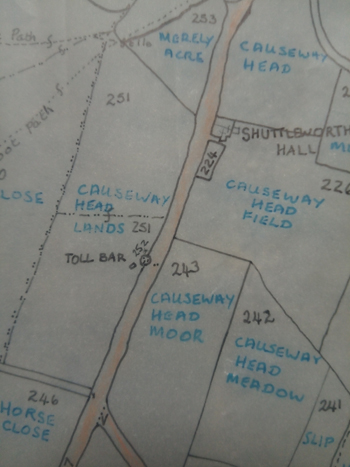


South of Greystones, at Blacko Laiths SD 8541 4187 there was a toll house. It is no longer there but there is now a commemorative plaque which also tells of a tragic accident which took place there.

The only toll house remaining on this stretch of road is the one at Barrowford at SD 8625 3983.


Arnoldsbiggin (Arnold's Building)
A name synonymous with Gisburn is the Lister family, who were Lords of the Manor of Gisburn from the reign of Edward II (1307-1327) when John Lister married Isabel, daughter of John of Bolton who owned the Manor of Midhope (Middop). We know the Lister family moved to Arnoldsbiggin (close to where Westby Hall Farm stands now), in 1520, when Thomas Lister married Effamia of Westby and that the family moved to Gisburne Park, now a hospital, in the 1730s.
Today all that remains of the site of Arnoldsbiggin, which stood virtually at the boundary of the parish of Rimington and Middop with Gisburn, and was abandoned on the Listers’ move to Gisburne Park. The OS map shows a fishpond at location SD 8216 4785, however now (September 2020) no evidence of that exists. The picture, by Robert Griffier, is of a ruined Arnoldsbiggin, with Pendle in the background.


Click the link below to see the will of Thomas Lister of Arnoldsbiggin 1707
Will of Thomas Lister of Arnoldsbiggin 1707 pdf
Bronze Age Axe
SD 8156 4595
A Bronze Age axe head was found in the grounds of Oak Tree House, Newby . It was unearthed by Mrs Eileen Anderson when she was digging in her garden in the 1970s. She was a keen supporter of Ribchester Roman Museum and took it to there for identification and donated it to them.


The museum kindly loaned it for the first local history exhibition held in 1988. The late Roger Dyson of Howgill Cottage provided an interpretive drawing for the event to show how the axe head would be attached to the wooden shaft.
Bulcock Monument
SD 8217 4385
The Bulcock Memorial is situated just off the lane leading from Twiston Lane to Clough Head, outside Clough Head garden. It was erected by Thomas Bulcock in 1863 in memory of his relations buried in Whalley and Downham churchyards. The Bulcock family had a long association with the area and in 1637 an earlier Thomas Bulcock gave a plot of land near Brownlow corner for a Quaker graveyard that still exists. Descendants of the Bulcocks, the Palmer family, still farm in Twiston.

Clapper Bridge over Thistleber Beck
SD 8163 4637
Stone slab bridge over beck

Field House
SD 8198 4708
Tablet on the wall
According to a past occupier of Field House, the history of the tablet on the wall there centred on a quarrel between neighbours, builder and owner, that raged for two years while Field House stood roofless!

A Stitch in Time


Chris Woodall, the current (2023) owner of Field House found this sampler in his attic. From the date, age and initials (the As are rather strange) it is known that she is Alice Ann Duckworth, who lived at that time in the shop at Stopper Lane. Her brothers included Francis, the composer, and Caleb, the jam manufacturer. Chris is shown handing over the sampler to John Spencer, who is Alice Ann's grandson. It is not known how the sampler came to be at Field House.
Howgill Packhorse Bridge
SD 8276 4597
Howgill Packhorse Bridge straddles a tributary of Howgill Beck. It was reputedly washed away in the flood of 1967, but a version of it still remains.

Lancashire and Yorkshire Railway
On 21st June, 1850 Chatburn Railway staion was opened, however it was not until 1879 that the stations at Rimington and Gisburn were opened. It was in 1880 that the line reached Hellifield. When the 1881 census was taken there was a Station Master, two railway labourers, two plate layers, two points men, a signal man and a railway contractor, all living in the village. Passenger numbers declined such that the station was closed in 1958 beating the otherwise inevitable Beeching axe by five years. The line between Clitheroe and Hellifield remains open for goods and the occasional excursion trains. When the West Coast Line is shut, this line is used for re-routing trains. Part of the station is now Station House (SD 8000 4612).



To read some memories of Rimington Railway station click here (PDF)
To find out more about Rimington Railway Station click here
Newby School
SD 8177 4597
There were two schools within the parish, Newby School and Rimington School, the latter built much later. It would be good to see an original plan or indenture of Newby School, what is now Pen-y-ghent, because the school did not take up the whole building. But more on that below.
Newby Day School was established in 1809, according to a school census completed after 1814 and signed by the then Vicar of Gisburn, Rev Knowles. It also shows that at the time of this census there were 20 boys and 4 girls attending Newby Day School and 25 boys and 25 girls attending Newby Sunday School, which had been established in 1811. Access to the school room was via the steps that still rise from Newby Lane roadside to the upper doorway.
It is interesting that there was an active Sunday School in the village from 1811 because Rimington's two chapels weren't built until some years later, and the parish church was three miles away in Gisburn. So who was giving the children their religious education? On page 3 of the 2016 Bicentennial celebration book on Salem Congregational Chapel it is noted that Rev George Partington of Colne sometimes preached in Newby Schoolroom. So maybe one of his flock was undertaking that task. However 'A History of Methodism in The Clitheroe Circuits Vol 1' by Cyril Ainsworth begins a paragraph – “A few years earlier a Sunday School had been started, and organised with considerable success, at nearby Newby, but it was not until 1815 that land was acquired in Stopper Lane giving the worshippers the opportunity to build a chapel.” Which implies it was members of the Wesleyan congregation that were providing the Sunday lessons.
Newby School closed in 1914, though it had not been used as a school for some time but as a reading room and venue for the annual Newby Ball, fondly remembered in a letter from Canada to a relative at Whytha Farm, and maybe other dances. (The Ball sounds very grand, yet not so grand that it warranted a report in the Clitheroe Times!)
The schoolroom was the length of the building beyond the steps and upper doorway near the roadside. The rest of the building was Newby School House. Its occupants can only be readily identified in the 1861 and 1871 Censuses, but the 1846 Rimington Tithe Award plan shows the building as a place of continual occupancy, though doesn't distinguish between what was the schoolroom and what was the school house, possibly because the school was on top of part of the school house.
The sale of the Newby School led to the formation of the Newby Educational Foundation Trust which still survives today. Qualifying children are given a small grant in recognition of their achievement. The school building comprised what is now a house known as Pen-y-ghent.
N.B. Newby Lane was much wider here than it is now. The whole school building stood in the middle of the lane with another lost lane heading down past Newby Hall Farm and beyond. If you stand at the iron gate above Pen-y-ghent and look through it, or look over the gate at the roadside at the top of the field you will see the lane used to be double the width it is now, and was so right up to Salem Chapel. There used to be a line of beech trees along the former lane boundary in the field behind Pen-y-ghent. They were cut down in the early 1960s.


Rimington School
SD 8122 4594
Rimington National School opened some time after Newby School at what is now Greystones in Stopper Lane on a date presently unknown but possibly in the early 1840s when it is identified as 'New School and Garden' in the 1846 Tithe Award Schedule.
There was a good number of scholars in the village to fill both schools right up into the 1870s but then the number dived by the 1880s as families moved away to the towns and cities or migrated abroad. By which time the schools had chequered histories and an uneven opening record such that eventually there were not enough children to warrant both being open. In time Rimington National School became the only one, probably by the early 1890s at a time when the woes of Newby School were being debated in no uncertain terms in letters to the Editor of the Clitheroe Times, and it was struggling to appoint a teacher according to a Blackburn newspaper.
The school not only catered for the local village children but was the nearest school for those living in Twiston too. It closed in May 1937 and the schoolchildren transferred to Gisburn Primary School which continues to be the main primary school for the area today. Any Twiston children would have then attended Downham School.




Bessie was a teacher at Rimington School from 1917 to her early death at the age of 42. She was born in Rimington, the daughter of Wilson Loynd the Railway Station Master. She is one of the children in the schoolchildren picture of 1905.
Roman Road
A section of the Roman Road from Ribchester to Elslack crosses Rimington from near the confluence of Twiston Beck and Ings Beck, and the section finishes on Coal Pit Lane just north of Howgill Lane SD 8447 4668. Some evidence of the road can be seen near where Howgill Lane meets the A 682 at SD 8341 462.


Ribble Valley Archaeology have a project looking at the section of this road that runs from the A59 to Coal Pit Lane. Y Click here to read about this project
Click here to read more about Ribble Valley Archaeology
Rufus Carr’s garage
SD 8119 4585
Rufus Carr’s inventive and mechanical skills helped him to build a popular garage business, with sites at Stopper Lane and Bawdlands, Clitheroe. He had a great passion for traction engines, restoring and exhibiting them and was the subject of several profiles in newspaper articles and magazines. In his early years he was known as a bit of an ‘airum scarum’ lad but is now a fondly remembered character who was famous for his brightly painted steamroller which would rumble heavily through the village after a visit to a local show. His original wooden garage was only demolished a few years ago. It had petrol pumps just to the right of the doorway.
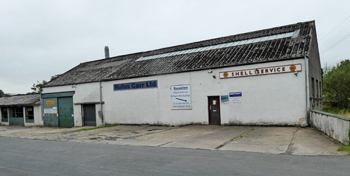
Salem Congregational Chapel
SD 8210 4573
Salem Congregational Chapel was founded in 1816 and is better known locally as Martin Top Chapel. It is still offering a warm welcome to worshippers. Its date of completion is marked out in smooth river pebbles in the ground in the chapel yard gateway – 1817.

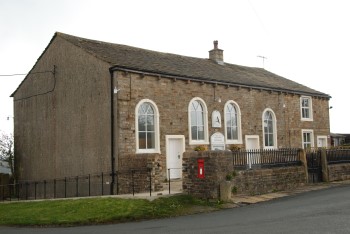
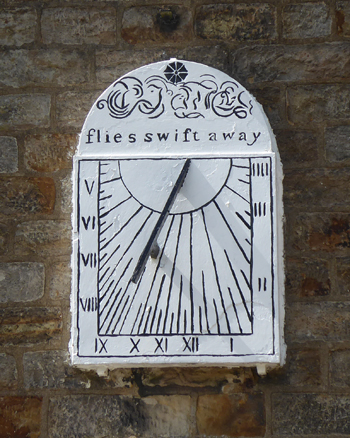
Swanside Packhorse Bridge
SD 7850 4538
The major building period for packhorse bridges was 1650 to 1750. Though not strictly in the parish it is very near to it. The charming and possibly early 17th century Swanside Packhorse Bridge, also known as Monks Bridge probably because it was on a route between Whalley Abbey and Sawley Abbey, supported pony traffic but not carts, as it is under 6ft wide.
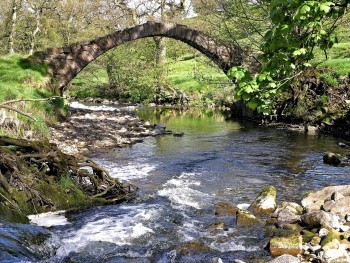
The Old Manor House
SD 8074 4589
The Old Manor House, Rimington was possibly the last house in the district with a thatched roof. In June 1935 the parish council sent a letter to the then owner, H.M. Walton Esq., expressing the hope that the property, then undergoing repair, would remain a thatched cottage ‘as it is one of the most picturesque old dwellings in Ribblesdale.’ Other Rimington buildings photographed with a thatched roof were the Black Bull Inn, Yew Tree Farm, Newby, and what are now Abbotsdene and Holmelea.



The Wesleyan Chapel
SD 8127 4588
Cyril Ainsworth's 'A History of Methodism in The Clitheroe Circuit Vol 1' gives a detailed account of the history of Stopper Lane Wesleyan Chapel. He mentions that Methodism earlier flourished in a farmhouse at Gazegill prior to the building of the chapel at Stopper Lane which was founded in 1815.It is most well known for its association with Francis Duckworth’s hymn tune ‘Rimington’.
The chapel had a gallery, the front of which was occupied by an orchestra providing the hymn music until an organ was installed in 1859. Francis and several of his brothers were part of the orchestra. The chapel was enlarged in 1887, and the organ was replaced a few years later. t was also sometimes the venue for village meetings. However the society numbers were never great and around 1950 were down to 10 when it was discovered that the building was unsafe due to a defective roof. Closure was recommended by a special committee in October, 1963.
I


Dorothy Cosgrove has kindly loaned a VERY small ( 86 mm x 57 mm) recipe book which was sold in aid of Rimington Methodist Chapel. The 'SALE OF WORK EFFORT' was held on February 4th 1939.

To see the complete set of recipes click here
To view the pictures in a larger format click on any of the images and use arrows to move to left or right. Click outside the image to return to the main screen.



























